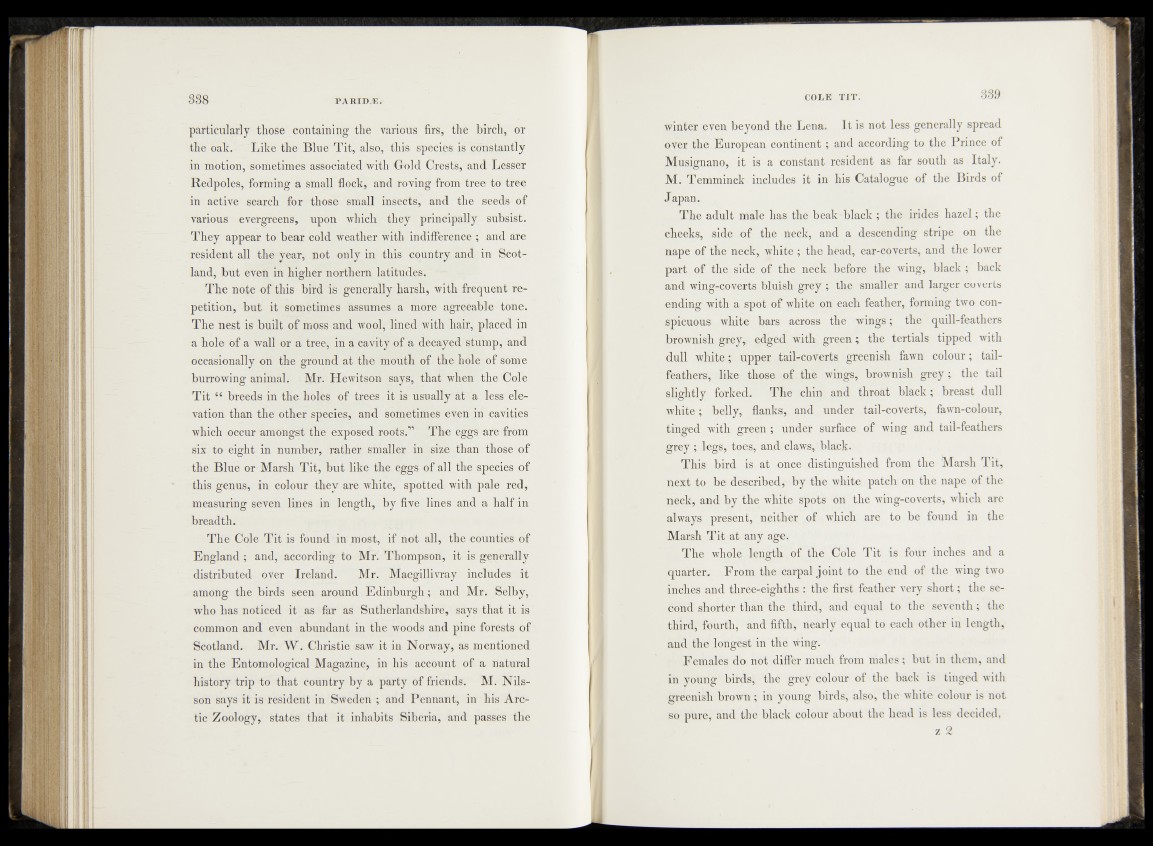
particularly those containing the various firs, the birch, or
the oak. Like the Blue Tit, also, this species is constantly
in motion, sometimes associated with Gold Crests, and Lesser
Redpoles, forming a small flock, and roving from tree to tree
in active search for those small insects, and the seeds of
various evergreens, upon which they principally subsist.
They appear to bear cold weather with indifference ; and are
resident all the year, not only in this country and in Scotland,
but even in higher northern latitudes.
The note of this bird is generally harsh, with frequent repetition,
but it sometimes assumes a more agreeable tone.
The nest is built of moss and wool, lined with hair, placed in
a hole of a wall or a tree, in a cavity of a decayed stump, and
occasionally on the ground at the mouth of the hole of some
burrowing animal. Mr. Hewitson says, that when the Cole
Tit “ breeds in the holes of trees it is usually at a less elevation
than the other species, and sometimes even in cavities
which occur amongst the exposed roots.” The eggs are from
six to eight in number, rather smaller in size than those of
the Blue or Marsh Tit, but like the eggs of all the species of
this genus, in colour they are white, spotted with pale red,
measuring seven lines in length, by five lines and a half in
breadth.
The Cole Tit is found in most, if not all, the counties of
England; and, according to Mr. Thompson, it is generally
distributed over Ireland. Mr. Macgillivray includes it
among the birds seen around Edinburgh; and Mr. Selby,
who has noticed it as far as Sutherlandshire, says that it is
common and even abundant in the woods and pine forests of
Scotland. Mr. W. Christie saw it in Norway, as mentioned
in the Entomological Magazine, in his account of a natural
history trip to that country by a party of friends. M. Nilsson
says it is resident in Sweden ; and Pennant, in his Arctic
Zoology, states that it inhabits Siberia, and passes the
winter even beyond the Lena. It is not less generally spread
over the European continent; and according to the Prince of
Musignano, it is a constant resident as far south as Italy.
M. Temminck includes it in his Catalogue of the Birds of
Japan.
The adult male has the beak black ; the irides hazel; the
cheeks, side of the neck, and a descending stripe on the
nape of the neck, white ; the head, ear-coverts, and the lower
part of the side of the neck before the wing, black ; back
and wing-coverts bluish grey ; the smaller and larger coverts
ending with a spot of white on each feather, forming two conspicuous
white bars across the wings; the quill-feathers
brownish grey, edged with green; the tertials tipped with
dull white; upper tail-coverts greenish fawn colour; tail-
feathers, like those of the wings, brownish grey; the tail
slightly forked. The chin and throat black; breast dull
white; belly, flanks, and under tail-coverts, fawn-colour,
tinged with green : under surface of wing and tail-feathers
grey ; legs, toes, and claws, black.
This bird is at once distinguished from the Marsh Tit,
next to be described, by the white patch on the nape of the
neck, and by the white spots on the wing-coverts, which are
always present, neither of which are to be found in the
Marsh Tit at any age.
The whole length of the Cole Tit is four inches and a
quarter. From the carpal joint to the end of the wing two
inches and three-eighths : the first feather very short; the second
shorter than the third, and equal to the seventh; the
third, fourth, and fifth, nearly equal to each other in length,
and the longest in the wing.
Females do not differ much from males; but in them, and
in young birds, the grey colour of the back is tinged with
greenish brown; in young birds, also, the white colour is not
so pure, and the black colour about the head is less decided,
z 2